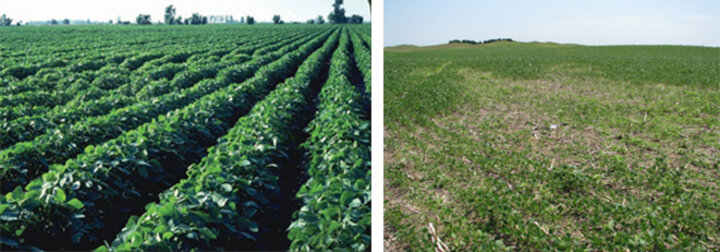Some Nebraska farmers managing for soybean cyst nematode (SCN) are noticing something different: They aren't getting the control they expect from planting an SCN-resistant variety. Why are their control measures becoming less effective?

SCN in Nebraska
SCN has now been confirmed in 59 counties covering almost the entire eastern half of Nebraska. These counties produce over 93% of Nebraska’s soybeans.
When SCN was first confirmed in Nebraska in Richardson County in 1986, only a few soybean varieties were resistant to it. By 2000, there were hundreds of SCN-resistant varieties. Today most varieties have some genetic resistance to SCN. (This resistance is transferred through normal breeding programs; SCN resistance is not a GMO.)
Greg Tylka, a nematologist at Iowa State University who researches soybean cyst nematodes, states, “Almost all SCN-resistant soybean varieties... were developed from the same soybean breeding line, or ‘source of resistance,' named PI 88788. These resistant varieties controlled most, over 90%, of SCN reproduction for many years. But researchers throughout the Midwest detected a troubling trend in recent years: SCN populations were becoming resistant to the resistance.”
A recent survey in Nebraska showed almost half (47%) of the fields tested had SCN populations that reproduced on PI 88788. In other states where SCN has been present longer, SCN is reproducing on over 90% of the soybean varieties using this source of resistance. The reproduction is not as great as it would be on an SCN-susceptible variety, but it is occurring at a rate that allows SCN egg counts in the soil to build up and increase rather than decrease.
Sometimes the growth of an SCN population in a field is hard to imagine because most of its life it's a microscopic roundworm in the soil or soybean root. Rather, think of managing SCN as you would a weed that has developed resistance to a particular herbicide. Continuing to use that same herbicide will give you more weed control than not using any herbicide, but it does not give you satisfactory control. Over time the problem weed will become a greater problem in your field.
Tylka says the bottom line is, “soybean varieties with PI 88788 SCN resistance no longer control SCN well in many fields... and farmers are losing yield as a result of increased SCN reproduction on resistant soybean varieties.”
This SCN resistance requires growers to change their SCN management practices to maintain yields and profitability in their soybean fields.
The recommendations we made 20 years ago to control SCN ― “rotate soybeans with a non-host crop like corn and plant an SCN-resistant variety when planting soybeans” ― worked great then, but today additional measures are needed.
New SCN Management Practices Needed
So what should growers keep doing and what should they change?
Test. Testing fields for SCN is not a new recommendation, but retesting infested fields about every six years is a new recommendation. If SCN wasn’t present six years ago and is now, you will likely have caught it before the population reaches a level that would significantly reduce yield.
The new recommendation is to retest infested fields about every six years. If your previous test was positive for SCN, sample at the same time of year and following the same crop as your first sample. SCN populations vary throughout the growing season and depending on whether they follow soybeans or a non-host crop.
If you originally sampled in the fall following soybeans, make sure your new sample is also taken in the fall following soybeans. Depending on your rotation, you may need to retest after five or seven years. This retesting will let you know if your current management practices are reducing the SCN population density (egg numbers) over time.
Select SCN-resistant varieties and rotate with a non-host crop. Plant SCN-resistant varieties and rotate with a non-host crop like corn.
Free SCN Testing
To encourage testing, the Nebraska Soybean Board has a great program that covers the cost of analyzing soil samples for SCN, normally a $20/sample cost.
To get the bags for this free soil analysis or for more information on identifying and managing SCN, contact your local Nebraska Extension office.
Consider adding a nematode-protectant seed treatment on your resistant variety. When managing SCN in your field, never use a seed treatment in place of a resistant variety, use it on a resistant variety.
Know Your Number and Adjust. If your SCN egg count is increasing, select SCN-resistant soybean varieties with sources of resistance other than PI 88788. Look for varieties that list “Peking” as the source of resistance. It is the most common source of resistance other than PI 88788, but is only found in about 2% of SCN-resistant varieties commercially available.
SCN Coalition
The SCN Coalition was formed in the 1990s to encourage farmers and agronomic professionals to test for SCN and manage it as if it was detected in a field. Their primary focus was on detection.
This group recently reorganized to address the problem of SCN reproducing on varieties using the PI 88788 source of resistance. Their new message is, “What’s your number?” and encourages soybean growers to periodically test to see if the SCN density (egg counts) in their SCN-infested fields is increasing or decreasing.
The SCN Coalition is funded by the United Soybean Board and the North Central Soybean Research Program (checkoff dollars) as well as with support from private industry partners. Visit the SCN Coalition’s website for resources to help you manage SCN.
Reference
Tylka, Greg, Reflecting on SCN in Iowa Through the Years in Iowa State University's Integrated Crop Management News, Sept. 10, 2018.

